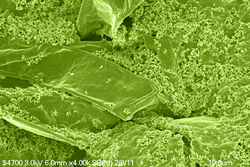Arsenic shields for rice

OUR FACULTY | University researchers have discovered a soil microbe that mobilizes an “iron shield” to block the uptake of toxic arsenic in rice.
Arsenic occurs naturally in rocks and soils, air and water, plants and animals. Chronic exposure to arsenic has been linked to cancer, heart disease and diabetes.
The UD finding gives hope that a natural, low-cost solution—a probiotic for rice plants—may be in sight to protect this global food source from accumulating harmful levels of one of the deadliest poisons on the planet.
Because rice is grown in water—often contaminated with arsenic in such hot spots as Bangladesh, India and China—it takes in 10 times more arsenic than do other cereal grains, such as wheat and oats. Rice is a staple in the diet of more than half the world’s population.
Harsh Bais, associate professor of plant and soil sciences, led the UD team that conducted the study. His team identified the special soil microbe, named “EA106” for UD alumna Emily Alff, AS09, EOE09, ANR12M, who isolated the strain when she was a graduate student in Bais’ lab. The microbe was found among the roots of a North American variety of rice grown commercially in California.
“This particular microbe, EA106, is good at mobilizing iron, which competes with the arsenic, effectively blocking arsenic’s pathway,” Bais explains. “An iron plaque forms on the surface of the roots that does not allow arsenic to go up into the rice plant.”
He and his team are now working to see if EA106 prevents arsenic accumulation in the grain.




